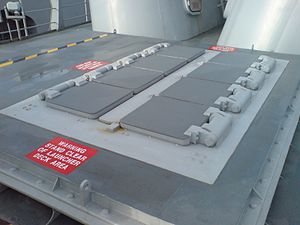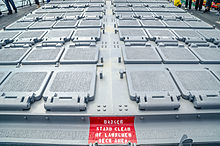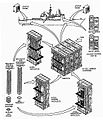| Mk 41 vertical launching system | |
|---|---|
 A single 8-cell Mk 41 VLS module fitted to New Zealand frigate HMNZS Te Kaha A single 8-cell Mk 41 VLS module fitted to New Zealand frigate HMNZS Te Kaha | |
| Type | Missile launching system |
| Place of origin | United States |
| Service history | |
| In service | 1986–present |
| Used by | United States Navy Royal Navy |
| Wars | Cold War Tanker War Gulf War Kosovo War War on Terror Red Sea crisis |
| Production history | |
| Designed | 1970s |
| Manufacturer | Martin Marietta Lockheed Martin |
| Variants | Mk 57 Mk 70 Mod 1 |
The Mark 41 vertical launching system (Mk 41 VLS) is a shipborne missile canister launching system which provides a rapid-fire launch capability against hostile threats. The vertical launching system (VLS) concept was derived from work on the Aegis Combat System.
History
Refinement of the initial concept of Aegis system in the 1960s continued through the 1960s and 1970s, and the Mk 41 was conceived in 1976. Originally, the system was only intended to fire the RIM-66 Standard missile, but the height of the Mk 41 was increased to accommodate the larger Tomahawk missile. The prototype for the launcher was tested and evaluated on board USS Norton Sound. The first operational launcher was installed aboard USS Bunker Hill.
Combat history
On 12 October 2016, USS Mason (DDG-87) was targeted by missiles fired from Yemeni territory while operating in the Bab-el-Mandeb strait. Mason was not hit by the two missiles, which were fired from near the city of Al Hudaydah. While the Navy is not certain whether the first incoming missile was intercepted or it just fell into the sea, officials claim Mason successfully intercepted the second missile at a distance of about 8 miles (13 km), marking the first time in history a warship destroyed an inbound anti-ship missile with a SAM in actual self-defense and the first time the Mk41 VLS did so.
Specifications
Mark 41 (Mk 41)
The missiles are pre-loaded into "canisters", which are then loaded into the individual "cells" of the launcher. A cell may have 1, 2, or 4 missiles. Several models of missiles are integrated into the Mk 41 and Mk 57 systems through the Host Extensible Launch System (ExLS) developed by Lockheed Martin.
Launcher cells are fitted to ships in 8 cell modules (2 rows of 4) that share a common uptake hatch (exhaust system) sited between the two rows. The Mk 41 VLS adopts modular design concept, which result in different versions that vary in size and weight due to different "canisters" in various modules. The height (determining missile length) of the launcher comes in three sizes: 209 inches (5.3 m) for the self-defense version, 266 in (6.8 m) for the tactical version, and 303 inches (7.7 m) for the strike version. The empty weight for an 8-cell module is 26,800 pounds (12.2 t) for the self-defense version, 29,800 pounds (13.5 t) for the tactical version, and 32,000 pounds (15 t) for the strike version. Ticonderoga cruisers and Arleigh Burke destroyers up to DDG-78 have a Strikedown module fore and aft, which consists of five cells and a collapsible crane for assisting with replenishment at sea. As replenishment of large missiles at sea was later seen as impractical and dangerous, Strikedown modules fell out of use on newer ships.
The Mk 41 is capable of firing the following missiles (height and pack count indicated where possible):
Surface-to-air
- RIM-66 Standard MR (SD height)
- RIM-156 Standard ER(TAC height)
- RIM-161 Standard Missile 3 (strike height)
- RIM-174 Standard ERAM / SM-6 (strike height)
- RIM-7 Sea Sparrow (SD height, 4-pack)
- RIM-162 ESSM (SD height, 4-pack, incompatible with older versions of 8-cell modules)
- CAMM (CAMM, CAMM-ER, CAMM-MR) (SD height, ExLS; 4-pack for CAMM and CAMM-ER, likely 2-pack for CAMM-MR)
- RIM-116 Rolling Airframe Missile (Block 2) (SD height, ExLS 4-pack)
Surface-to-surface
- RGM-109 Tomahawk (strike height)
- Joint Strike Missile (TAC height)
- RGM-179 JAGM (SD height, ExLS 4-pack)
- LRASM (BTV) with a Mk-114 booster rocket (strike height)
Anti-submarine
- RUM-139 VL-ASROC (TAC height)
Decoy
- Nulka (SD, ExLS 4-pack)
Mark 57 (Mk 57) PVLS

The Mk 57 Peripheral Vertical Launch System (PVLS) used on the Zumwalt-class destroyers is composed of much larger VLS cells capable of venting much larger volume and mass of exhaust gasses (mass flow rate), but is an evolution of the smaller unarmored Mk 56 VLS. The Mk 57 PVLS are designed to be installed on the ship periphery with armor on the inboard boundary, instead of in centralized magazines used in the Mk 41.
Developed by Raytheon, Mk 57 provides backward compatibility with existing missiles while allowing new missiles with significantly increased propulsion and payloads. While allowing for larger missiles than the Mk 41, the primary improvement of Mk 57 is its exhaust gas management system which can accommodate new missile designs having up to 45 percent greater rocket motor mass flow rate than that of Mk 41. The unique symmetric geometry of the U-shaped gas management system facilitates the egress of gases, while minimizing flow into adjacent cells and reversed flow into the active cell. Another advantage is the elimination of the water deluge system, which is used to cool the missile canister in the event that the missile restraint bolts do not release after rocket motor ignition. Elimination of the water deluge system significantly reduces maintenance and personnel requirements, and protects against accidental missile wet-down.
| Missiles | 4 cells |
|---|---|
| Width | 7.25 ft (2.21 m) |
| Length | 14.2 ft (4.3 m) |
| Height | 26 ft (7.9 m) |
| Weight | 33,600 lb (15,200 kg) |
| Maximum canister width | 28 in (0.71 m) |
| Maximum canister length | 283 in (7.2 m) |
| Maximum canistered weight | 9,020 lb (4,090 kg) |
Variants

- MK 41 Mod 0, Ticonderoga-class cruisers, two 61 cell Vertical Launcher Mk 158 Mod 0 or Mod 1, forward and aft.
- MK 41 Mod 1, Spruance-class destroyers, 61 cells forward.
- MK 41 Mod 2, Arleigh Burke-class destroyers, DDG-51 to DDG-78, one 29 cell Vertical Launcher Mk 159 Mod 0 forward, one 61 cell Vertical Launcher Mk 158 Mod 0 aft.
- MK 41 Mod unknown, Constellation-class frigates, 32 cells.
- MK 41 Mod unknown, Álvaro de Bazán-class frigates (Spain), 48 cells.
- MK 41 Mod unknown, Deveselu Military Base
- MK 41 Mod 3, Brandenburg-class frigates (Germany), 16 cells.
- MK 41 Mod 5, Anzac-class frigates (Australia, New Zealand), 8 cells
- MK 41 Mod 7, Arleigh Burke-class destroyers, DDG-79 to DDG-91, one 32 cell Vertical Launcher Mk 177 Mod 0 forward, one 64 cell Vertical Launcher Mk 176 Mod 0 aft.
- MK 41 Mod 8, Barbaros-class frigates (Turkey), 8 or 16 cells
- MK 41 Mod 9, De Zeven Provinciën-class frigates (Netherlands), 40 cells
- MK 41 Mod 10, Sachsen-class frigates (Germany), 32 cells
- MK 41 Mod 15, Arleigh Burke-class destroyers, DDG-92 and up, one 32 cell Vertical Launcher Mk 177 Mod 3 forward, one 64 cell Vertical Launcher Mk 176 Mod 2 aft.
- MK 41 Mod 16, Adelaide-class frigates (Australia), 8 cells
- MK 70 Mod 1, containerized four-cell launcher
- Long-Range Missile (LMSL) Battery, containerized single cell launcher on a US Marine Corps ROGUE- Fires JLTV vehicle
Operators

- Adelaide-class frigate - (8 cells) (Retired)
- Anzac-class frigate - (8 cells)
- Hobart-class destroyer - (48 cells)
- Hunter-class frigate - (32 cells)
- Iroquois-class destroyer - (29 cells) (Retired)
- River-class destroyer - (24 cells)
- Adelaide-class frigate - (8 cells)
- Iver Huitfeldt-class frigate - (32 cells)
- Pohjanmaa-class corvette - (8 or 16 cells)
- Sachsen-class frigate - (32 cells)
- Brandenburg-class frigate - (16 cells)
- F126 frigate (16 cells)
- Maya-class destroyer - (96 cells)
- Atago-class destroyer - (96 cells)
- Kongō-class destroyer - (90 cells)
- Hyūga-class helicopter destroyer - (16 cells)
- Murasame-class destroyer - (16 cells)
- Takanami-class destroyer - (32 cells)
- Akizuki-class destroyer - (32 cells)
- Asahi-class destroyer - (32 cells)
- Mogami-class frigate - (16 cells)
- Asuka - (8 cells)
- De Zeven Provinciën-class frigate - (40 cells)
- Fridtjof Nansen-class frigate - (8 or 16 cells)
- Chungmugong Yi Sun-shin-class destroyer (KDX-II) - (32 cells)
- Sejong the Great-class destroyer (KDX-III) - (80 cells)
- Álvaro de Bazán-class frigate - (48 cells)
- F110-class frigate - (16 cells)
- Kaohsiung-class tank landing ship - (Test ship)
- Naresuan-class frigate - (8 cells)
- Bhumibol Adulyadej-class frigate - (8 cells)
- G-class frigate - (8 cells)
- Barbaros-class frigate - (16 cells)
- Type 26 frigate - (24 cells)
- Type 31 frigate - (32 cells)
- Spruance-class destroyer - (61 cells, installed on 24 of 31 vessels) (Retired)
- Arleigh Burke-class destroyer - (90 or 96 cells)
- Ticonderoga-class cruiser - (122 cells)
- Zumwalt-class destroyer - (80 Mk 57 cells)
- Constellation-class frigate - (32 Mk 41 cells)
- DDG(X) class destroyer - (At minimum up to 128 cells (4x32 module configuration), dependent on number of hypersonic missiles carried as per current US Navy design proposal)
Other American VLSs
Smaller ships may use a Mk 48 VLS to launch the RIM-7 Sea Sparrow and later the RIM-162 ESSM. Each canister hosts one RIM-7 or two RIM-162s, and each module consists of two canisters: the smaller modules provide more versatility. The Mk 56 VLS is a later, lighter evolution based on modules of 4 ESSM canisters.
US Submarines use a Mk 45 VLS.
Gallery
-
 The VLS cells onboard USS San Jacinto.
The VLS cells onboard USS San Jacinto.
-
 A Tomahawk missile canister being loaded into a VLS aboard the Arleigh Burke-class destroyer USS Curtis Wilbur
A Tomahawk missile canister being loaded into a VLS aboard the Arleigh Burke-class destroyer USS Curtis Wilbur
-
 VLS cells open for inspection aboard USS Fitzgerald
VLS cells open for inspection aboard USS Fitzgerald
-
 An SM3 departs the Mk 41 VLS aboard USS Lake Erie with uptake hatch and cell hatch open.
An SM3 departs the Mk 41 VLS aboard USS Lake Erie with uptake hatch and cell hatch open.
-
 VLS Strikedown crane folded, aboard USS Mitscher
VLS Strikedown crane folded, aboard USS Mitscher
-
 VLS Strikedown crane extended, aboard USS Hopper
VLS Strikedown crane extended, aboard USS Hopper
-
 Diagram of a Mk 41 Mod 0 VLS.
Diagram of a Mk 41 Mod 0 VLS.
See also
- GJB 5860-2006 – A vertical launching system of People's Liberation Army Navy
- K-VLS – A vertical launching system of Republic of Korea Navy
- Poliment–Redut vertical launching system – A vertical launching system of Russian Navy, navalized version of S-350
- 3S-14 – A vertical launching system of Russian Navy for cruise, anti-ship and anti-submarine missiles
- Sylver – A vertical launching system designed by DCNS
- Typhon missile launcher – A vertical launching ground system
References
- "Mark 41 Vertical Launching System". Retrieved 21 September 2011.
- ^ Friedman, Norman (2006). The Naval Institute Guide to World Naval Weapon Systems (5th ed.). Annapolis, MD: Naval Institute Press. p. 600.
- ^ LaGrone, Sam (12 October 2016). "Pentagon Pledges to Respond in 'Appropriate Manner' After New Yemen Missile Attack on USS Mason". USNI News. U.S. Naval Institute. Retrieved 12 October 2016.
- Copp, Tara (13 October 2016). "Aegis defense system helped stop missile attack on USS Mason". Stars and Stripes. Retrieved 15 October 2016.
- ^ "Host Extensible Launching System" (PDF). Lockheed Martin. 2019. Retrieved 1 November 2023.
- "Exclusive: New Details on the Kongsberg Vertical Launch Joint Strike Missile (VL JSM)". Navy Reckognition. 14 January 2015. Retrieved 9 January 2022.
- "Lockheed Martin Successfully Launches First LRASM Boosted Test Vehicle From MK 41 VLS". Navy Recognition. 18 September 2013. Retrieved 2023-10-30.
- ^ "MK41 VERTICAL LAUNCHING SYSTEM" (PDF).
2019
- ^ NAVEDTRA 14324, Gunner's Mate, Chapter 7.
- Allison, George (2018-04-17). "CAMM completes qualification trials from Lockheed Martin launcher". Retrieved 2023-11-01.
- "CAMM | FORCE PROTECTION, Ground Based Air Defence". MBDA. Retrieved 2023-11-01.
- "Common Anti Air Missile (CAMM) - Think Defence". www.thinkdefence.co.uk. 2022-11-05. Retrieved 2023-11-01.
- "UK, Poland To Advance Development Of Longer Range Air Defense Missile | Aviation Week Network". aviationweek.com. Retrieved 2023-09-07.
- Mk 57
- "MK 57 Vertical Launching System Zumwalt Class Destroyer Program" (PDF).
- ^ "U.S. Navy Guided Missile Launcher Systems". Archived from the original on 2022-07-25. Retrieved 2014-05-15.
- "USMC Systems Command Provides Details on Long-Range Missile Battery". 14 August 2023.
- Everington, Keoni (20 November 2019). "Mysterious radar ship spotted off coast of S. Taiwan". www.taiwannews.com.tw. Taiwan News. Retrieved 15 April 2020.
- "Mk-48 Vertical Launching System VLS RIM-7 RIM-162 Sea Sparrow". www.seaforces.org.
- "Mk-56 Vertical Launching System GMVLS RIM-162 ESSM Missile". www.seaforces.org.
- "Mk-45 Vertical Launching System VLS Submarines SSN SSGN". www.seaforces.org.
External links
- FAS - Mk 41
- Lockheed Martin - Mk 41 VLS Factsheet Archived 2016-03-04 at the Wayback Machine